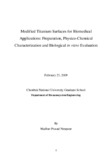Please use this identifier to cite or link to this item:
http://archive.nnl.gov.np:8080/handle/123456789/257| Title: | Modified titanium surfaces for biomedical applications: preparation, physico-chemical characterization and biological In vitro evaluation |
| Authors: | Neupane, Madhav Prasad |
| Keywords: | Anodization Cell viability Osteoblast Quenching Cell proliferation Titanium dioxide Nanotube Anodic oxidation Osseointegration |
| Issue Date: | 5-Dec-2017 |
| Abstract: | Metallic titanium and its alloys have become key materials for biomedical applications, mainly owing to their compatibility with human tissues and their mechanical strength. They are used as implant materials such as dental implants and various orthopedic and osteosynthesis systems in contact with bone. Titanium covered with a passive oxide film, is a rather bioinert material. Titanium and its alloys have high enough strength and toughness to bear loads. In order to obtain the favorable properties of titanium metal as implantation, titanium surfaces are modified with different methods. A number of different surface modification methods have been invented and developed; of which many suffer from low durability and relatively low adhesion of coating on the metal substrate. This thesis deals with the modification of pure titanium surface by different methods anodic oxidation, quenching, and cyclic voltammetry to obtain favorable properties of titanium surface with improved coating integrity and adhesion. The resulting modified surfaces were characterized using Scanning Electron Microscopy (SEM), Energy Dispersive X-ray Spectrometer (EDS), X-ray Diffraction (XRD), and surface roughness test by using Surftest Formtracer. Also after modifying the titanium surfaces the biological in vitro evaluation was performed. Chapter I of this thesis highlights literature overview of history and types of methods of surface modification of titanium, applications, and effects of surface characteristics on biological responses with modified surfaces. Remaining chapters demonstrate the modification, characterization and their potential applications in in vitro biological evaluation. Chapter II highlights the control quenching of titanium metal to obtain metal products having particular surface properties. Quenching of metal also relive the internal stresses of metal. This chapter focuses on surface topography, roughness, crystallite size, and crystal intensity of quenched surface with heating temperature. Cytotoxicity of the quenched surface was evaluated with MTT assay. The surface roughness and crystallite size was increased and cytotoxicity of quenched surface was decreased as the heating temperature increased. Similarly, crystalline intensity was varied at different temperature. In chapter III, micro-arc oxidation (MAO) surface modification method is evaluated as a technique to obtain the favorable properties of titanium with improved coating integrity and adhesion. MAO, an advanced anodization method, allows for anodic oxide layer formation and incorporation of P ions from electrolyte in one single process step. The method exploits the dielectric breakdown of anodic oxide film at high electrical field strength to produce a porous oxide layer with a thickness of a few micrometers that contains different amounts of P ions. A major advantage is the interfacial integrity as a result of the electrochemical reaction between titanium metal and electrolyte. Additionally, MAO is a fast single-step process that is less expensive and much more suited to coat implants than other deposition process such as plasma spraying. This chapter focuses on two main topics: ● The investigation of the MAO surface modification process, also known as anodic spark deposition, interms of process mechanism and the influence of process parameter “electrolyte pH” on the resulting MAO coating properties. ● The development of bioactive coating consisting of a phosphated titanium oxide matrix that facilitates possible growth of hydroxyapatite as well as osteoblast response. Firstly, the influence of the process parameter “electrolyte pH” on the dielectric breakdown properties, the coating structure, crystallinity, and chemical composition were investigated by using phosphate buffer electrolyte. The resulting coatings were characterized using SEM, EDS, XRD and surface roughness test. It was illustrated that the parameter “electrolyte pH” influences the surface topography, crystallinity, and surface roughness of modified surface. Secondly, the phosphate buffer electrolyte with different pH was found to incorporate P ions in MAO coatings with different quantity. A cell-culture study was carried out with MC3T3 mouse osteoblasts in order to test the biocompatibility of the coating with different pH modified surfaces in comparison to uncoated CP titanium surfaces. The results indicated that the MAO coatings are not less biocompatible than the commercially available implant surfaces with respect to cell growth and cytotoxicity evaluation. Finally, the MAO process was investigated by means of a high-resolution SEM to study the mechanism of film formation. Chapter IV deals the formation of titanium oxide nanotubes in acidic fluoride solution by anodic oxidation. After the formation of nanotubes its stability and crystal phase transition was studied at different temperatures. Finally, formation model of titanium oxide nanotube was proposed. At the end, chapter V demonstrates the corrosion of titanium metal at different electrolyte pH. Also the numbers of potentiodynamic cycles were applied on previously formed oxide film. The corrosion of metal linearly depends on electrolyte pH as well as number of potentiodynamic cycles. In summary, the thesis will direct the idea of different surface modification methods, which can provide a better method as compared to either one method. And it also appreciates to use those modified implant materials that comes from the different modification methods would be the best candidate in the future for dental and orthopedic implant. |
| Description: | A Dissertation submitted to the faculty of Chonbuk National University in partial fulfillment for the requirements for the degree of Doctor of Philosophy, Department of Bionanosystem Engineering, 2008. |
| URI: | http://103.69.125.248:8080/xmlui/handle/123456789/257 |
| Appears in Collections: | 500 Natural sciences and mathematics |
Files in This Item:
| File | Description | Size | Format | |
|---|---|---|---|---|
| Soft Copy.pdf | 1.51 MB | Adobe PDF |  View/Open |
Items in DSpace are protected by copyright, with all rights reserved, unless otherwise indicated.